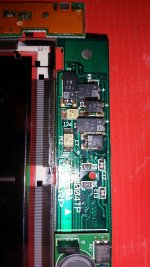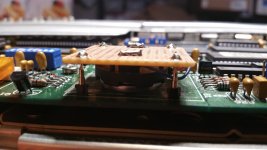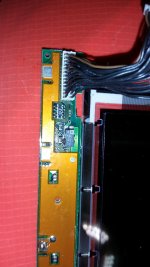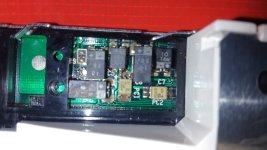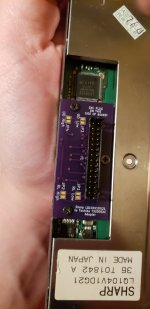T-Squared
Veteran Member
Urgh. This is one of the best computers I have ever seen, but the worst deteriorating system. Curse the capacitors!
Despite that, I have made efforts, and progress, thanks to an idea that Adalbert from Hackaday and Youtube brought forth.
I'm planning on putting a bit of a spin on his work, to make certain aspects less overbearing, and hopefully, at the same time, allowing old stock to have a purpose, and take up close-to the same room as the original components.
I see that I'm not the only one to have a problem with the rotting and leaking capacitors in both the screen and the computer's power supply. I went on a rant in 2017 about the original SHARP LQ10D013 screens being available, but not only being paywalled behind a ridiculous price most places online (At LEAST $1400?!), but also the fact that this stock is also rotting and degrading! (I tried buying another one for around $435 including S&H from China back then, but it was in the exact same condition as the Toshiba's original screen when I received it.) I did eventually find a "replacement" in the form of a Toshiba LTM10C013 (from one of the worst 386/486 systems I've ever come across, the T6400DXC), but that was extremely hard on the eyes, and something about its colors didn't agree with me (Yes, this an actual approximation):
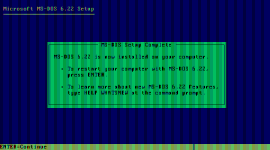
I've held onto another screen that I got around that time, which, this time, will seem to be clearer and less-harsh on the eyes (A Sharp LQ104V1DG21), along with 3D-printed supports both from Adalbert and myself (Don't worry, what you see as scratches, bubbles, and, at the corners of the screen, lifting of plastic, is just protection film that I haven't removed yet):
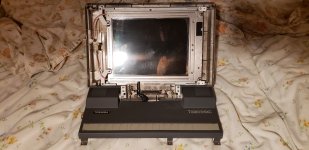
Right now I'm working on a Hirose DF9MA-31P-1V (LCD connector) to DF11-28DP (Toshiba video connector) adaptor, again based on Adalbert's design, so that way it can cleanly connect to the Toshiba without hacking-in the video connections. I might make the design available, if I complete it.
The power supply, though, is a different matter. I like the idea of the new design, but I'm not quite liking the idea of an external battery. I plan to add a charging circuit to the supply and get a LIPO battery to put inside the space once occupied by part of the power supply, as well as a visual charging meter on the proprietary peripheral slot, just so I don't have to guess how long a battery will last.
I do like the idea of the speakers, but I have also changed that as well. I have some 40mm speakers from an old cheap Chinesium (Thank you, CuriousMarc for adding a new word to my vocabulary) Bluetooth speaker that had its USB charging port ripped off, so I've 3D-printed supports for those as well.
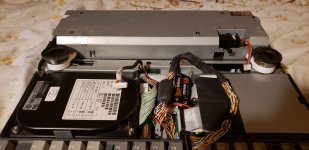
As for connecting the speakers to sound, I'm going to use a small slit on the side, normally used for holding the ISA card cover, as a way for the cables and 3.5mm connector to come out to the sound card.
As you can also see, I had to replace the original Citizen 26-pin floppy, but that was a while ago. I found a nice 26-pin-to-34-pin floppy adapter that still does need a 26-pin ribbon cable, but only needs two pins on the adapter to be tied to GND in order to work: https://www.ebay.com/itm/1655719231...uid=Gj9QMdF5TXq&widget_ver=artemis&media=COPY
If you've been looking closely at this project, you may have noticed that the LCD is missing a backlight inverter board. For the moment, I have an LS520 inverter on its way, since it uses a connector standard that hasn't been used in almost 15 years. Chinese universal backlight inverter boards might work, but they don't use the correct connector.
Anyways, I've been chomping at the bit to get this done. I'm working on the computer's power supply, and the video adaptor board, but I need some help with finding a good charging circuit.
Despite that, I have made efforts, and progress, thanks to an idea that Adalbert from Hackaday and Youtube brought forth.
I'm planning on putting a bit of a spin on his work, to make certain aspects less overbearing, and hopefully, at the same time, allowing old stock to have a purpose, and take up close-to the same room as the original components.
I see that I'm not the only one to have a problem with the rotting and leaking capacitors in both the screen and the computer's power supply. I went on a rant in 2017 about the original SHARP LQ10D013 screens being available, but not only being paywalled behind a ridiculous price most places online (At LEAST $1400?!), but also the fact that this stock is also rotting and degrading! (I tried buying another one for around $435 including S&H from China back then, but it was in the exact same condition as the Toshiba's original screen when I received it.) I did eventually find a "replacement" in the form of a Toshiba LTM10C013 (from one of the worst 386/486 systems I've ever come across, the T6400DXC), but that was extremely hard on the eyes, and something about its colors didn't agree with me (Yes, this an actual approximation):

I've held onto another screen that I got around that time, which, this time, will seem to be clearer and less-harsh on the eyes (A Sharp LQ104V1DG21), along with 3D-printed supports both from Adalbert and myself (Don't worry, what you see as scratches, bubbles, and, at the corners of the screen, lifting of plastic, is just protection film that I haven't removed yet):

Right now I'm working on a Hirose DF9MA-31P-1V (LCD connector) to DF11-28DP (Toshiba video connector) adaptor, again based on Adalbert's design, so that way it can cleanly connect to the Toshiba without hacking-in the video connections. I might make the design available, if I complete it.
The power supply, though, is a different matter. I like the idea of the new design, but I'm not quite liking the idea of an external battery. I plan to add a charging circuit to the supply and get a LIPO battery to put inside the space once occupied by part of the power supply, as well as a visual charging meter on the proprietary peripheral slot, just so I don't have to guess how long a battery will last.
I do like the idea of the speakers, but I have also changed that as well. I have some 40mm speakers from an old cheap Chinesium (Thank you, CuriousMarc for adding a new word to my vocabulary) Bluetooth speaker that had its USB charging port ripped off, so I've 3D-printed supports for those as well.

As for connecting the speakers to sound, I'm going to use a small slit on the side, normally used for holding the ISA card cover, as a way for the cables and 3.5mm connector to come out to the sound card.
As you can also see, I had to replace the original Citizen 26-pin floppy, but that was a while ago. I found a nice 26-pin-to-34-pin floppy adapter that still does need a 26-pin ribbon cable, but only needs two pins on the adapter to be tied to GND in order to work: https://www.ebay.com/itm/1655719231...uid=Gj9QMdF5TXq&widget_ver=artemis&media=COPY
If you've been looking closely at this project, you may have noticed that the LCD is missing a backlight inverter board. For the moment, I have an LS520 inverter on its way, since it uses a connector standard that hasn't been used in almost 15 years. Chinese universal backlight inverter boards might work, but they don't use the correct connector.
Anyways, I've been chomping at the bit to get this done. I'm working on the computer's power supply, and the video adaptor board, but I need some help with finding a good charging circuit.
Last edited:


